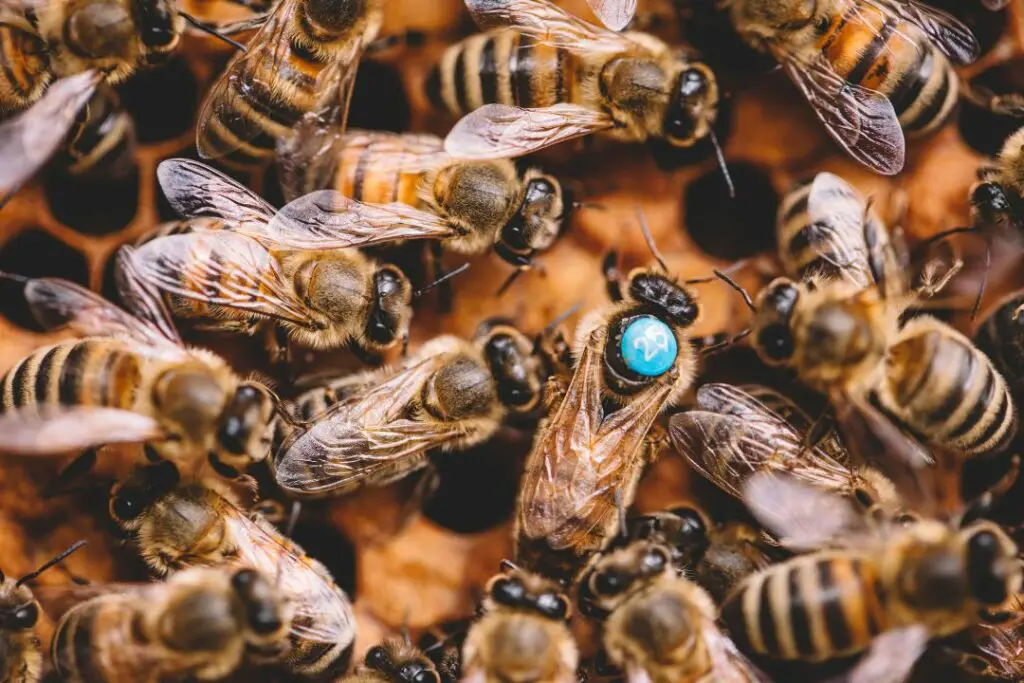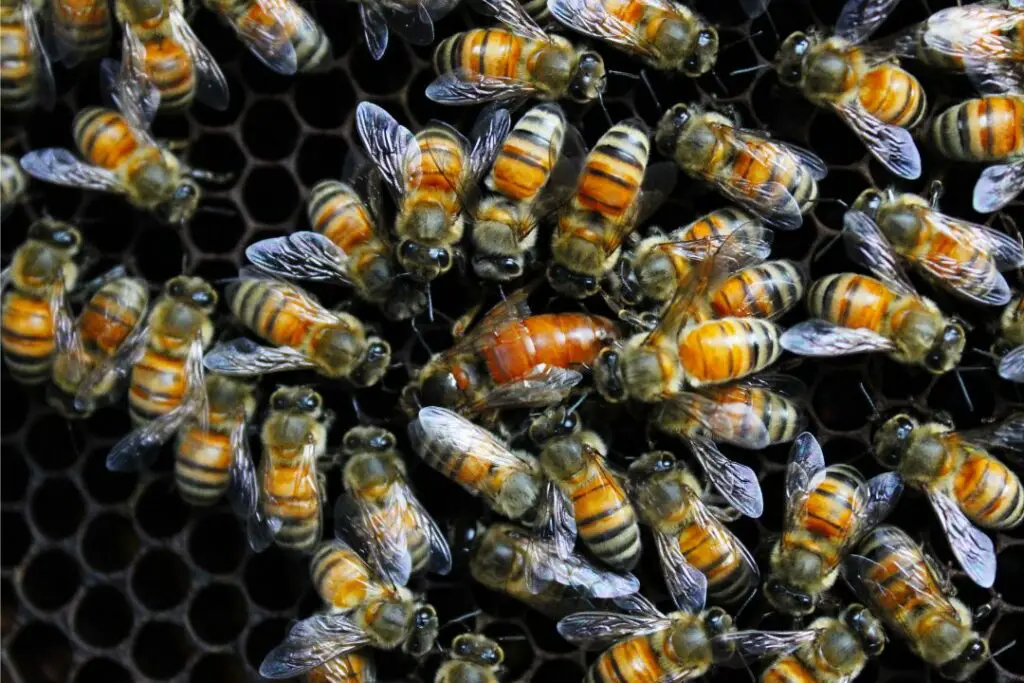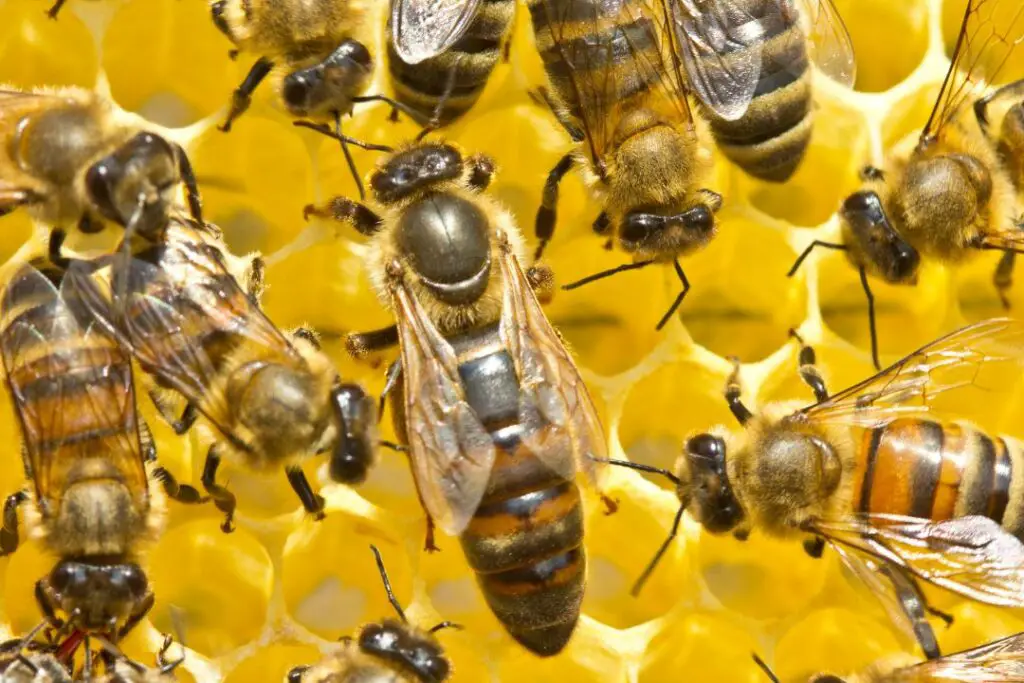Did you know worker bees can turn on their queen and commit treason?
The matriarch is the most prized colony member, so why would the hive’s inhabitants turn on their ruler?
Let’s dive into the fascinating world of bees to find out why these normally calm insects decide to overthrow their queen and why it might be a good thing.
Understanding Hive Society
Before diving into the reasons behind this behaviour, it’s essential to understand the structure of a bee colony:
- The Queen: The heart of the hive. She’s the primary egg-layer and emits pheromones that maintain order and cohesion in the colony.
- Worker Bees: Female bees that do not reproduce. They perform various tasks like foraging, nursing, and guarding the hive.
- Drones: Male bees whose primary role is to mate with a new queen. Different to workers with no sting and no ability to forage or raise the next generation of bees.
With this structure in place, the hive operates like a well-oiled machine. However, when something goes awry, the worker bees might decide it’s time for a change at the top.

Supersedure – The Natural Succession
Supersedure is a fascinating and crucial process in the life of a honey bee colony. It’s replacing an existing queen with a new one, initiated by the worker bees.
The workers begin by raising new queen cells, usually due to the current queen’s declining health or productivity.
Once the new queen emerges, matures, and is ready, the old queen is either killed or driven out of the hive. This natural transition ensures the colony’s continued health and survival.
But what prompts these bees to make such a significant decision? Let’s delve into the various reasons for supersedure.
Declining health of the queen
As the queen ages and comes to the end of her annual lifecycle, her health may deteriorate. An ailing queen can become a liability and spell disaster for the colony’s survival.
A sick queen might be unable to lay eggs efficiently or produce offspring with compromised health. This can lead to an overproduction of male offspring that can’t forage, leading to starving eggs and larvae.
Reduced pheromone production
The queen bee produces specific pheromones, often called “queen substances.” These pheromones are vital in maintaining the colony’s cohesion and suppressing the workers’ ovaries.
If the queen’s pheromone production drops, it can lead to unrest in the hive. Worker bees might start laying eggs, leading to a chaotic hive environment.
Decreased egg-laying
One of the primary roles of the queen is to lay eggs. As she ages or if she becomes unhealthy, her egg-laying rate can decline.
A reduced egg-laying rate can jeopardize the colony’s future, as there won’t be enough new bees to replace the older generation, leading to the eventual collapse of the colony.
Physical damage or injury
Queens can get injured during their mating flights, by beekeepers during hive inspections, or due to other accidents within the hive.
An injured queen might be unable to perform her duties efficiently, prompting the worker bees to seek a replacement.
Poor genetics
Sometimes, a queen might produce offspring that are not robust or have genetic defects. They won’t be as skilled at foraging for resources and may not even reach adulthood.
Poor-quality offspring can weaken the colony, making it more susceptible to diseases, pests, and other threats.
External stressors
Factors like diseases, pests (like Varroa mites), or adverse environmental conditions can put untold stress on the colony.
In response, the colony might opt for a new queen, hoping her genetics offer better resistance or adaptability.
The presence of multiple queens
Occasionally, a hive might end up with more than one queen. This can happen if beekeepers introduce a new queen or multiple queens emerge simultaneously.
Worker bees might choose to keep the stronger queen and initiate supersedure for the other.

Mutiny – When Things Go Wrong
Mutiny, in the context of honey bee colonies, refers to the sudden and often aggressive act of worker bees turning against their queen.
Unlike the more organized process of supersedure, mutiny is spontaneous and can be triggered by several factors. Let’s jump into the hive to learn more.
Introduction of a foreign queen
Beekeepers might introduce a new queen to a colony in their management practices. If this introduction is not done carefully, the existing worker bees might reject her.
Sensing the new queen as an outsider, the worker bees might ball around her, leading to her death.
Poor brood pattern
Inconsistent or spotty brood patterns, missing eggs or larvae in the comb cells can indicate a problem with the queen’s ability to lay eggs.
Worker bees perceive this as a sign of a failing queen and may choose to kill her in favour of a new virgin queen.
The presence of disease or parasites in the queen
Just like any other bee, the queen can also be affected by various bee diseases or parasites.
If the worker bees detect that the queen is diseased or compromised, they might eliminate her to protect the colony.
Invasion
Invasion in the context of honey bee colonies typically refers to one species or subspecies of bee taking over another’s hive.
These invasions can be fascinating and upsetting as a more dominant colony of bees overruns a previously healthy hive. I only know of a few instances of this happening, so let’s find out more.
Cape honey bee
The Cape honey bee (Apis mellifera capensis) from South Africa has a unique ability. Worker bees can lay eggs that develop into females, usually clones of themselves.
When Cape honey bee workers invade other honey bee colonies, they start laying these eggs. Over time, the original colony’s population is replaced by the invaders, leading to the original queen’s death and the takeover of the hive.
Africanized honey bee
Africanized honey bees, often termed “killer bees,” are a hybrid of European and African honey bees. They are known for their aggressive response to predators, chasing them for up to a kilometre.
Since their introduction in Brazil in the 1950s, they have spread throughout South and North America, often taking over local bee populations. Their aggressive nature can also make them a threat to humans, with lots of fatalities for those unfortunate to get on the wrong side of them.
Asian honey bee vs. European honey bee
In some regions worldwide, the Asian honey bee (Apis cerana) has been observed invading European honey bee (Apis mellifera) hives.
While the exact dynamics can vary, in some cases, the Asian honey bees might rob resources or even establish themselves in the hive by removing the current queen for their own.
In Conclusion
Now we know why a normally functioning colony rejects its queen in favour of newer genetics and some of the more sinister reasons a queen gets marked for death.
Why not head over to our fascinating article about how bees can swim short distances or find out more about the sweeter side of bees in our guide on how bees produce honey?
Or pick one of our recommended reads below, packed with unique takes on the world of bees and other pollinators.





